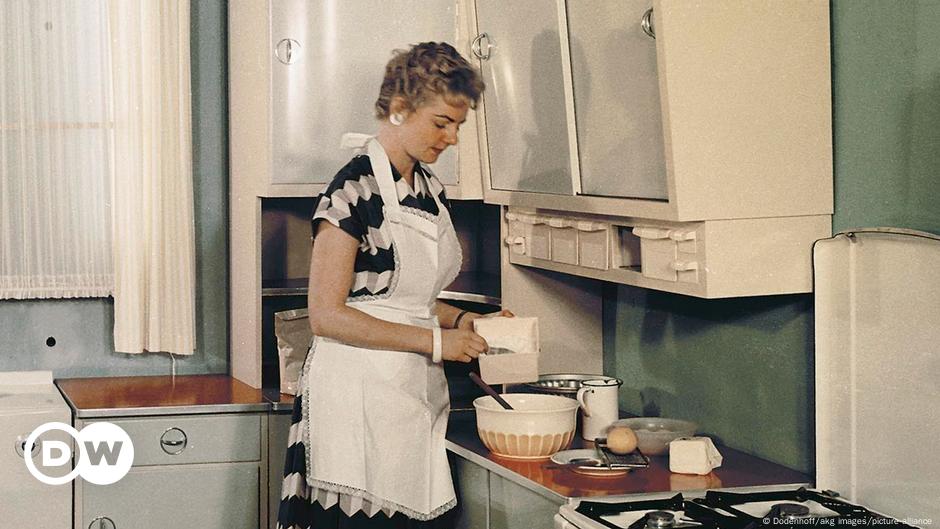“If I had known I would have to talk about this damned kitchen for the rest of my life, I would have never built it!” said 100-year-old Margaret Schütte-Lihotzky in an interview in 1998.
The kitchens he designed in the 1920s reflected architectural history and revolutionized the lives of public housing residents by creating a new functional, well-equipped culinary space.
Named the “Frankfurt Kitchen”, Schütte-Lihotzky created a piece of pioneering social architecture that has defined the kitchen to this day.
The designer was also a women’s rights activist and was celebrated as a heroine of the resistance against the Nazi dictatorship.
Margaret, who died in 2000 at the age of 103, aimed throughout her life to improve the lives of others through her work.
Changing working class lives with architecture
Schütte-Lihötzky developed during peak industrialization, a time of demographic shift from rural areas to cities as people looked for work in new factories.
But living conditions in the crowded, working-class districts of cities in Weimar Germany and Austria, such as Berlin, Frankfurt, and Vienna, were sometimes characterized by disease, poverty, and lack of sanitation.
As a young Viennese architecture student, Schütte-Lihotzky had a unique perspective on the struggles of working families in overcrowded tenements.
In 1917, she was doing research for an architectural competition and designed a housing complex based on the practical needs of residents, including more air and light.
Adopting the idea that “form follows function,” Schütte-Lihotzky moved away from the decorative architectural style of the previous century and embraced the functionality of “New Objectivity.”
For him, architecture was a response to social problems. This attitude was largely influenced by his background.
From housing to kitchen design
Born in 1897 into a middle-class, intellectual Viennese family, Schütte-Lihötzky’s childhood was immersed in art and culture as well as politics.
His mother was associated with the Viennese art scene and pacifist and feminist circles. As a child, Margaret was aware that she was relatively privileged, which shaped her understanding of design and architecture and her decision to work on social housing projects.
After World War I, there was an urgent need for housing in devastated Europe. New housing estates with social housing were built quickly and cheaply for the growing working class – and for those who had lost their homes in the war.
Building director Ernst May initiated the “New Frankfurt” housing program in Frankfurt am Main. His goal was to eliminate the housing shortage in 10 years.
May commissioned Schutte-Lihotzky to design kitchens suitable for residential complexes. This kitchen was created to make optimum use of limited space in new buildings and improve the everyday life of residents.
The young architect got the job: how many steps would a kitchen user have to take to get from A to B? How do they move? Where is it best to keep cooking utensils? How can one keep an eye on children while working in the kitchen?
Introduction of modern ‘fitted’ kitchen
The result was a room about 3.5 meters (11.4 ft) long and 2 meters (6.5 ft) wide, with sliding glass doors that allowed views into the living room and a large window to let in light.
The kitchen was equipped with floor-to-ceiling cabinets, a worktop, a sink with a drain, drawers for kitchen waste and aluminum chutes for the most essential cooking ingredients.
As new apartment blocks were built in Frankfurt, the individual modules had to be manufactured industrially in large numbers.
To overcome initial skepticism about this new type of kitchen, Ernst May promoted Margaret’s invention as “built by a woman for women.”
The “Frankfurt Kitchen” was born and revolutionized household chores.
However, the growing feminist movement of the time was critical of the idea that women did all the household work in the kitchen. The allegation was that the efficiency of this kitchen has tied women even closer to the kitchen.
Nevertheless, Schütte-Lihotzky intended this kitchen to relieve the burden on women.
resistance against nazis
Despite criticism, Frankfurt Kitchen was successful.
Orders came in from all over the world: the French Labor Minister alone wanted to install 260,000 units.
Despite international recognition, the young designer was misunderstood and primarily wanted to improve the lives of the working class.
This almost became his ruin during the Nazi era. After Austria’s annexation into Nazi Germany, he fought underground against the Nazis as a communist. She was arrested and narrowly escaped execution.
After World War II, Margarethe Schütte-Lihotzky became involved in the peace and women’s rights movement. She gave lectures, mentored young women architects, and built apartments and kindergartens in West Germany, Russia, Cuba, and East Germany.
Edited by: Sarah Huckle






Leave a Reply